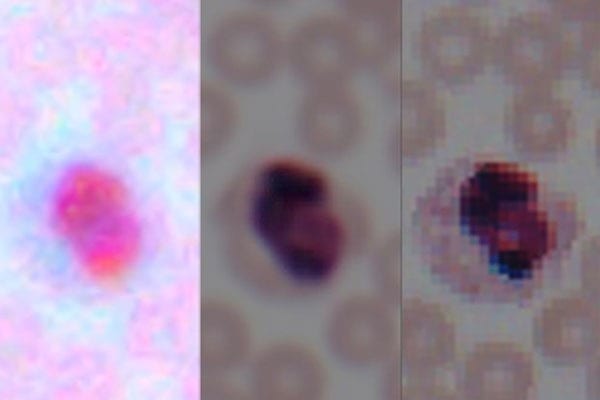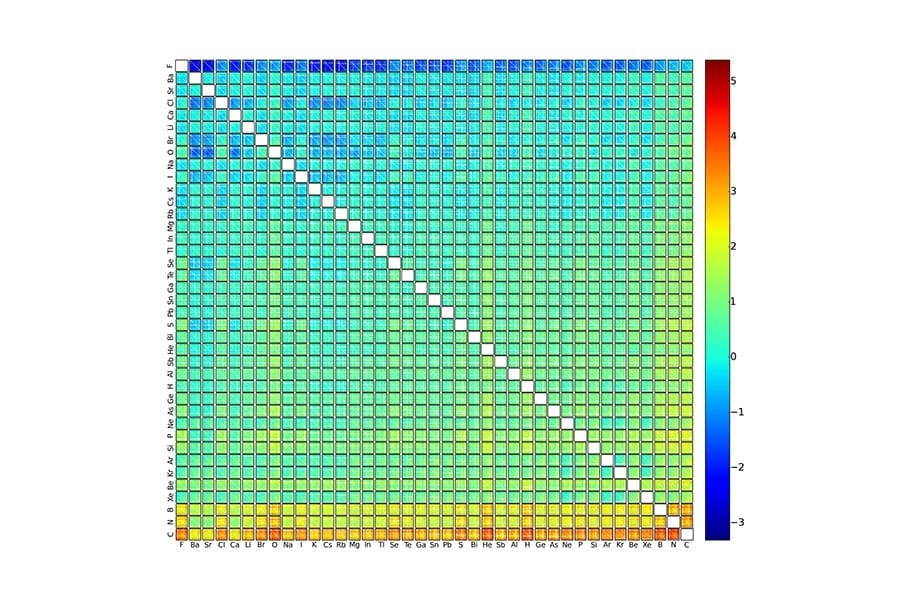
Image of a blood smear from a cell phone camera (left), following enhancement by the algorithm (center), and taken by a lab microscope (right).
Researchers at the UCLA Samueli School of Engineering have demonstrated that deep learning, a powerful form of artificial intelligence, can discern and enhance microscopic details in photos taken by smartphones. The technique improves the resolution and color details of smartphone images so much that they approach the quality of images from laboratory-grade microscopes.
The advance could help bring high-quality medical diagnostics into resource-poor regions, where people otherwise do not have access to high-end diagnostic technologies. And the technique uses attachments that can be inexpensively produced with a 3-D printer, at less than $100 a piece, versus the thousands of dollars it would cost to buy laboratory-grade equipment that produces images of similar quality.
Cameras on today’s smartphones are designed to photograph people and scenery, not to produce high-resolution microscopic images. So the researchers developed an attachment that can be placed over the smartphone lens to increase the resolution and the visibility of tiny details of the images they take, down to a scale of approximately one millionth of a meter.
But that only solved part of the challenge, because no attachment would be enough to compensate for the difference in quality between smartphone cameras’ image sensors and lenses and those of high-end lab equipment. The new technique compensates for the difference by using artificial intelligence to reproduce the level of resolution and color details needed for a laboratory analysis.
The research was led by Aydogan Ozcan, Chancellor’s Professor of Electrical and Computer Engineering and Bioengineering, and Yair Rivenson, a UCLA postdoctoral scholar. Ozcan’s research group has introduced several innovations in mobile microscopy and sensing, and it maintains a particular focus on developing field-portable medical diagnostics and sensors for resource-poor areas.
“Using deep learning, we set out to bridge the gap in image quality between inexpensive mobile phone-based microscopes and gold-standard bench-top microscopes that use high-end lenses,” Ozcan said. “We believe that our approach is broadly applicable to other low-cost microscopy systems that use, for example, inexpensive lenses or cameras, and could facilitate the replacement of high-end bench-top microscopes with cost-effective, mobile alternatives.”
He added that the new technique could find numerous applications in global health, telemedicine and diagnostics-related applications.
The researchers shot images of lung tissue samples, blood and Pap smears, first using a standard laboratory-grade microscope, and then with a smartphone with the 3D-printed microscope attachment. The researchers then fed the pairs of corresponding images into a computer system that “learns” how to rapidly enhance the mobile phone images. The process relies on a deep-learning–based computer code, which was developed by the UCLA researchers.
To see if their technique would work on other types of lower-quality images, the researchers used deep learning to successfully perform similar transformations with images that had lost some detail because they were compressed for either faster transmission over a computer network or more efficient storage.
Learn more: Deep learning transforms smartphone microscopes into laboratory-grade devices
The Latest on: Deep learning
[google_news title=”” keyword=”deep learning” num_posts=”10″ blurb_length=”0″ show_thumb=”left”]
via Google News
The Latest on: Deep learning
- Intel quietly launched mysterious new AI CPU that promises to bring deep learning inference and computing to the edge — but you won't be able to plug them in a motherboard ...on April 27, 2024 at 5:33 am
I ntel has launched a new AI processor series for the edge, promising industrial-class deep learning inference. The new ‘Amston Lake’ Atom x7000RE chips offer up to double the cores and twice the ...
- New multi-task deep learning framework integrates large-scale single-cell proteomics and transcriptomics dataon April 26, 2024 at 7:35 am
The exponential progress in single-cell multi-omics technologies has led to the accumulation of large and diverse multi-omics datasets. However, the integration of single-cell proteomics and ...
- Europe taps deep learning to make industrial robots safer colleagueson April 26, 2024 at 1:07 am
European researchers have launched the RoboSAPIENS project to make adaptive industrial robots more efficient and safer to work with humans.
- AI-powered 'deep medicine' could transform health care in the NHS and reconnect staff with their patientson April 25, 2024 at 10:20 am
Today's NHS faces severe time constraints, with the risk of short consultations and concerns about the risk of misdiagnosis or delayed care. These challenges are compounded by limited resources and ...
- Nvidia to buy Israeli deep learning co Deci AI - reporton April 25, 2024 at 12:44 am
Deci AI is one of three Israeli companies developing language models - the others being Amnon Shashua's AI21 Labs and Tabnine. Both Run:ai and Deci AI will help Nvidia's customers produce more from ...
- Researchers develop deep learning alternative to monitoring laser powder bed fusionon April 24, 2024 at 9:12 am
Many things can go wrong when additively manufacturing (AM) metal and without in-situ process monitoring, defects can only be detected and characterized after a product is built. Most commonly, ...
- Deep learning predicts heart arrhrythmia 30 minutes in advanceon April 23, 2024 at 4:15 am
Atrial fibrillation is the most common cardiac arrhythmia worldwide with around 59 million people concerned in 2019. This irregular heartbeat is associated with increased risks of heart failure, ...
- Researchers develop deep-learning model capable of predicting cardiac arrhythmia 30 minutes before it happenson April 22, 2024 at 1:23 pm
Atrial fibrillation is the most common cardiac arrhythmia worldwide with around 59 million people concerned in 2019. This irregular heartbeat is associated with increased risks of heart failure, ...
- Using deep learning to image the Earth's planetary boundary layeron April 18, 2024 at 1:43 pm
Although the troposphere is often thought of as the closest layer of the atmosphere to the Earth's surface, the planetary boundary layer (PBL)—the lowest layer of the troposphere—is actually the part ...
via Bing News










